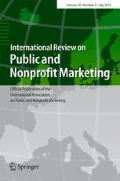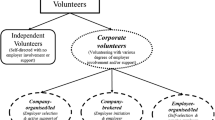Abstract
Despite volunteering be usually associated to non-profit organisations, more and more companies have been implemented in their Corporate Social Responsibility (CSR) some volunteering activities involving their internal publics. This research aims to analyse if there are significant differences between two groups of volunteers (corporate and non-profit) regarding the motivations to volunteer and to analyse if the socio-demographic variables are the ones that most discriminate the two types of volunteers. The results indicate that the motivational factor recorded as the most relevant for both type of volunteers was Values and the less scored was Career. The results also evidence higher scores for all motivations for Non-profit volunteers when compared with the Corporate ones, pointing out to the existence of significant differences between the two types of volunteers for all motivations, except in the case of Understanding. Income and Values were the variables that most contributed for that distinction.
Similar content being viewed by others
References
Agostinho, D., & Paço, A. (2012). Analysis of the motivations, generativity and demographics of the food bank volunteer. International Journal of Nonprofit and Voluntary Sector Marketing, 17, 249–261.
Basil, D. Z., Runte, M. S., Easwaramoorthy, M., & Barr, C. (2009). Company support for employee volunteering: a national survey of companies in Canada. Journal of Business Ethics, 85, 387–398.
Booth, J., Park, K., & Glomb, T. (2009). Employer-supported volunteering benefits: gift exchange among employers, employees, and volunteer organizations. Human Resources Management, 48(2), 227–249.
Brand, M., Kerby, D., Elledge, B., Burton, T., Coles, D., & Dunn, A. (2008). Public health’s response: citizens’ thoughts on volunteering. Disaster Prevention and Management, 17, 54–61.
Briggs, E., Peterson, M., & Gregory, G. (2010). Toward a better understanding of volunteering for nonprofit organizations: explaining volunteers; pro-social attitudes. Journal of Macromarketing, 30(1), 61–76.
Burns, D., Reid, J., Toncar, M., Fawcett, J., & Anderson, C. (2006). Motivations to volunteer: the role of altruism. International Review on Public and Nonprofit Marketing, 3, 79–91.
Chácon, F., Vecina, M., & Dávila, M. (2007). The three-stage model of volunteers’ duration of service. Social Behavior and Personality, 35(5), 627–642.
Clary, E., & Snyder, M. (1991). A functional analysis of altruism and prosocial behavior: the case of volunteerism. Review of Personality and Social Psychology, 12, 119–148.
Clary, E., & Snyder, M. (1999). The motivations to volunteer: theoretical and practical considerations. Current Directions in Psychological Science, 8, 156–159.
Clary, E., Snyder, M., Ridge, R., & Copeland, J. (1998). Understanding and assessing the motivations of volunteers of volunteers: a function approach. Journal of Personality and Social Psychology, 74, 1516–1530.
Cnaan, R., & Goldberg-Glen, R. (1991). Measuring motivation to volunteer in human services. Journal of Applied Behavioral Science, 27(3), 269–284.
Delicado, A., Almeida, A., & Ferrão, J. (2002). Caracterização do voluntariado em Portugal. Lisboa: Comissão Nacional para o Ano Internacional dos Voluntários.
Farrell, J. M., Johnston, M. E., & Twynam, G. D. (1998). Volunteer motivation, satisfaction, and management at an elite sporting competition. Journal of Sport Management, 12, 288–300.
Ferreira, M. R., Proença, T., Proença, J. F. (2011). An empirical analysis about motivations among hospital volunteers, Faculty of Economics from the University of Porto. Working Papers, No. 418.
Finkelstein, M., Penner, L., & Brannick, M. (2005). Motive, role identity and prosocial personality as predictors of volunteer activity. Social Behavior and Personality, 33, 403–417.
Fischer, L., Mueller, D., & Cooper, P. (1991). Older volunteers: a discussion of the Minnesota senior study. The Gerontologist, 31, 183–193.
Fisher, P. J., & Cole, K. M. (1993). Leadership and management of volunteer programs. San Francisco: Jossey-Bass Publishers Inc.
Gaskin, K., & Smith, J. (1995). A new civic Europe: The extent and nature of volunteering in Europe. London: The Volunteer Centre.
Gidron, B. (1978). Volunteer work and its rewards. Volunteer Administration, 11, 18–32.
Hartenian, L. S., & Lilly, B. (2009). Egoism and commitment: a multidimensional approach to understanding sustained volunteering. Journal of Managerial Issues, 21(1), 97–110.
Latham, G. P., & Pinder, C. C. (2005). Work motivational theory and research at the dawn of the twenty-first century. Annual Review of Psychology, 5, 485–516.
Liu, G., & Ko, W. (2011). Social alliance and employee voluntary activities: a resource-based perspective. Journal of Business Ethics, 104, 251–268.
Malanska, H. (1993). Women volunteers at GMHC (pp. 110–125). London: Women and AIDS.
Marta, E., & Pozzi, M. (2008). Young people and volunteerism: a model of sustained volunteerism during the transition to adulthood. Journal of Adult Development, 15, 35–46.
Marta, E., Guglielmetti, C., & Pozzi, M. (2006). Volunteerism during young adulthood: an Italian investigation into motivational patterns. Voluntas: International Journal of Voluntary and Nonprofit Organizations, 17, 221–232.
Martín, M., & Gago, E. (2001). Coexistencia do voluntariado y trabajo asalariado en las ONG de Acción Social. Documentación Social. Enero-Marzo, 122, 85–103.
Morrow-Howell, N., Hinterlong, J., Rozario, P. A., & Tang, F. (2003). Effects of volunteering on the well-being of older adults. Journal of Gerontology, 58B(3), S137–S145.
Mozes, M., Josman, Z., & Yaniv, E. (2011). Corporate social responsibility organizational identification and motivation. Social Responsibility Journal, 7(2), 310–325.
Omoto, A., & Snyder, M. (1995). Sustained helping without obligation: motivation, longevity of service, and perceived attitude change among AIDS volunteers. Journal of Personality and Social Psychology, 68, 671–686.
Omoto, A., & Snyder, M. (2002). Considerations of community: the context and process of volunteerism. American Behavioral Scientist, 45, 846–867.
Paço, A., & Agostinho, D. (2012). Does the kind of bond matter? The case of food bank volunteer. International Review on Public and Nonprofit Marketing, 9(2), 105–118.
Pajo, K., & Lee, L. (2011). Corporate-sponsored volunteering: a work design perspective. Journal of Business Ethics, 99(3), 467–482.
Papadakis, K., Griffin, T., Frater, J. (2004). Understanding volunteers motivations. Northastern Recreation Research Symposium, GTR-NE: 321–326.
Peloza, J., & Hassay, D. (2006). Intra-organizational volunteerism: good soldiers, good deeds and good politics. Journal of Business Ethics, 64(4), 357–379.
Peloza, J., Hudson, S., & Hassay, D. (2009). The marketing of employee volunteerism. Journal of Business Ethics, 85(2), 371–386.
Proteau, L., & Wolff, F. (2008). On the relational motive for volunteer work. Journal of Economic Psychology, 29(3), 314–335.
Snyder, M., & Omoto, A. (1999). Who helps and why? The psychology of AIDS volunteerism. Helping and Being Helped. Naturalistic Studies, 213–239.
Stukas, A., & Daly, E. (2006). Lessons from research on volunteering from mobilizing adults to volunteers for positive youth development, The Search Institute Series on Developmentally Attentive Community and Society. 4(2), 65–82.
Wei, Y., Donthu, N., & Bernhardt, K. (2011). Volunteerism of older adults in the United States. International Review Public and Nonprofit Marketing. doi:10.1007/s12208-011-0069-6.
Wilson, J. (2000). Volunteering. Annual Review of Sociology, 26, 215–240.
Zappalà, G., & McLaren, G. (2004). A functional approach to employee volunteering: an exploratory study. Australian Journal on Volunteering, 9(1), 41–54.
Zweigenhaft, R., Armstrong, J., Quintis, F., & Riddick, A. (1996). The motivations and effectiveness of hospital volunteers. The Journal of Social Psychology, 136, 25–34.
Acknowledgments
NECE–R&D Centre funded by the Multiannual Funding Programme of R&D Centres of FCT (Portuguese Foundation for Science and Technology).
Author information
Authors and Affiliations
Corresponding author
Rights and permissions
About this article
Cite this article
do Paço, A., Agostinho, D. & Nave, A. Corporate versus non-profit volunteering—do the volunteers’ motivations significantly differ?. Int Rev Public Nonprofit Mark 10, 221–233 (2013). https://doi.org/10.1007/s12208-013-0101-0
Received:
Accepted:
Published:
Issue Date:
DOI: https://doi.org/10.1007/s12208-013-0101-0




